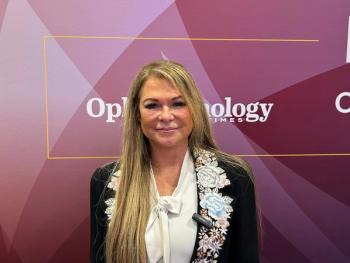
OCT angiography measures ONH blood flow
An experimental OCT angiography system can image both surface and deep blood flow at the optical nerve head.
Take-Home:
An experimental OCT angiography system can image both surface and deep blood flow at the optical nerve head.
By Fred Gebhart; Reviewed by David Huang, MD, PhD
Portland,OR-It has long been recognized that alternations in blood flow at the optical nerve head (ONH) are associated with glaucoma. Now, there is growing evidence to support that theory and that vascular insufficiency may precede elevated IOP.
New optical coherence tomography (OCT) technology offers the promise of using OHN perfusion to evaluate glaucoma and progression of the disease, according to David Huang, MD, PhD.
“Angiography-using very high speed OCT-can image blood flow from the large retinal vessels right down to the capillaries,” said Dr. Huang, professor of ophthalmology and biomedical engineering, Casey Eye Institute, Oregon Health & Science University in Portland, OR. “It is noninvasive . . . no injection of fluorescein dye or other contrast agent is needed.
“It is (also) three-dimensional, so you can measure flow at different depths,” he said.
Dr. Huang is lead author on “Measurement of ONH blood flow in glaucoma by OCT angiography.
(LEFT) Normal Control: In vivo 3-D volumetric optical coherence tomography angiography of the optic nerve head (ONH). En face maximum projection angiogram (3 X 3 mm) of the ONH of normal control (left) and preperimetric glaucoma (right). (RIGHT) Preperimetric Glaucoma: The density of the microvascular network in the ONH was visibly decreased in the glaucomatous eye. The vascular density could be quantified by a flow index. (Images courtesy of Yali Jia)
Evidence
The new technology combines an ultra-high-speed OCT unit currently being used for research and a novel, split-spectrum amplitude-decorrelation angiography (SSADA) algorithm that speeds up angiography scans by at least 4-fold.
Measuring perfusion at the ONH is not a new concept, but it has never been reduced to a useful clinical tool, Dr. Huang said.
Fluorescein angiography can provide helpful information for superficial ONH flow, but cannot image the posterior ciliary artery circulation.
The fluorescein contrast agent can also cause nausea and anaphylaxis, which makes it impractical to use as a standard clinical tool.
Doppler OCT can measure total retinal blood flow, but cannot image microcirculation because flow velocity is too low. Other laser and ultrasound techniques can show differences in blood flow between normal and glaucomatous eyes, but variation due to technique is too great to allow use as a reliable diagnostic tool.
“We have been conducting our studies using an experimental 100 KHz swept-source OCT that was developed by the MIT Optic & Quantum Electronic Group and my lab,” Dr. Huang said. “This is about four times faster than the current generation of commercial OTC systems . . . (which) means this technique is not immediately applicable to clinical practice, but there are next-generation OCT systems coming on the market at 70 KHz that will have sufficient speed.
“Higher speeds are coming in the near future,” he said.
Digging deeper
The experimental device offers 100,000 axial scans per second, a 1050-nm tunable laser for deep penetration, and 5.3 μm axial resolution in tissue.
The newly developed SSADA algorithm uses intrinsic contrast to produce flow images rather than an exogenous contrast material.
The algorithm improves the signal-to-noise ratio for flow detection, shows more of the continuous microvascular network than has been visible using earlier algorithms, and allows for the automated removal of motion errors.
At the current stage of development, a three-second scan can acquire a three-dimension image 3 mm by 3 mm. Image sizes will increase as scan rates increase, Dr. Huang said, but in the meantime, multiple images can be stitched together digitally to produce flow maps of larger areas.
A pilot study to investigate the ability of the new system to distinguish between normal eyes and glaucoma eyes was highly encouraging.
While the study population was small-20 patients with normal eyes and 10 patients with glaucoma-the system produced very robust results.
“We have data to show that you can distinguish between glaucoma and normal at 100% sensitivity and 100% specificity,” he said. “Variability between visits was 1.1% and inter-subject variability was 4.8% for normal eyes.
“These are very good precision values that allow you to measure between individuals . . . this is as good as structural measurements we take using OCT,” he said.
Variability has not yet been measured for glaucomatous eyes, he added, although it is likely to be higher than in normal eyes.
Data from the pilot study also showed statistically significant differences in visual field, structure, and blood flow between normal and glaucomatous eyes.
Glaucoma was associated with a 19% drop in blood flow in the optic disc (p < 0.0001).
OCT angiography also revealed reduced ONH blood flow in pre-perimetric glaucoma, an association between declining OHN flow, and declining visual field as measured by pattern standard deviation.
“We have an ongoing study to see if ONH flow will predict future glaucoma progression,” Dr. Huang said. “Vascular risk factors have been studied in populations, but there was never a device that could measure blood flow with enough precision to hope to have predictive value in the individual patient.
“With this new technology, OCT angiography might be suitable for clinical use with further validation and demonstration of actual predictive value,” he said.
David Huang, MD, PhD
Dr. Huang has a financial interest in Optovue, which may benefit commercially from the results of this research and technology development. These potential conflicts of interest have been reviewed and managed by OHSU.
Newsletter
Don’t miss out—get Ophthalmology Times updates on the latest clinical advancements and expert interviews, straight to your inbox.



















































.png)


